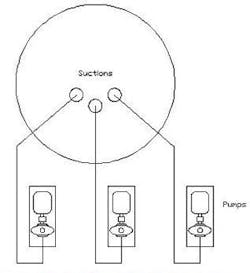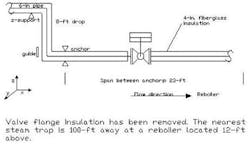Process Puzzler: Root Out Rumbling
THIS MONTH'S PUZZLER
Our contact HCl condenser/scrubber operates with two 1,750-rpm circulating pumps and one spare at a pressure of about 12 psia. There are three 350-mm suction lines. Their bells (90° elbows) reach to 200 mm from the tank bottom; the bells' exteriors are only 280-mm apart! The suction length is about 25 ft with four short-radius elbows and a butterfly valve. The low/low pump trip is set at 50%, about 6.6 ft from bottom, while the low alarm is at 60%, about 7.5 ft. The suctions are separate but the discharges connect to a common manifold. The two operating pumps supply a total of 5,500 gallons per minute to a cooling water exchanger and then to either a 300-mm circulation spray nozzle (40 ft above tank bottom) or three 80-mm nozzles. With the pumps running, level drops from 55% to 42% during circulation when the packing is wetted. The fiber-glass piping rumbles from the suction lines to the spray nozzles. One pipe support for the 300-mm spray nozzle already is broken. Are we dealing with cavitation or something else? How can we address this situation?
IT'S NOT CAVITATION
The problem is poor suction flow. Proving this could be the challenge, however, if you can't model the system using, e.g., computational fluid dynamics. You'd have to compare the dynamics with those of other vessels that are designed properly. While the pumps and tanks may differ, this may be the only option available.
Cut into the suction pipe for two pressure taps, 180° apart. If possible, put these taps in a straight pipe, with one at the top and the other at the bottom. Density might be another useful measurement. Don't use radiation and sonic because the fiber-glass pipe may not have a uniform diameter.
Now, let's consider standard engineering practices. Assuming equal pumps, the suction-line velocity is 0.4085×(5,500/2)/(13.46)2 or 6.2 feet per second (fps). To prevent vortex formation, tank liquid level must be 6.2 ft above the lip of the suction pipe: 200/(304.8) + 6.2 = 6.9 ft from tank bottom. "Cameron Hydraulic Data," 19th ed., pg. 1-25, suggests one ft submergence (for vortex) per fps suction flow as measured at the suction lip. The net positive suction head available (NPSHA) is roughly 23 ft H2O, ignoring the distance from the bell to the pump eye.
These calculations indicate a few problems: 1) the suction velocity maximum should be less than 6 fps (Cameron); 2) 6.2-ft submergence is acceptable given the 6.6-ft low-low pump trip (LL), provided little gas is in the column; 3) suction design isn't even close to Cameron's recommends of a suction bell diameter four times the suction pipe diameter; and 4) the NPSHA looks a little tight but this shouldn't be a big problem. With the LL this low, the suction problem will worsen once the packing above is wetted and level drops.
Although modifying the suction bells will reduce the suction problem, it would be best to move the suction lines for the pumps to the other side of the small sump (see Figure 1) and expand the suction bells as much as possible. Using flow straighteners or installing suction in a stillwell off to the side of the tank are alternatives.
Dirk Willard, contract staff engineer
Hemlock Semiconductor, Hemlock, Mich.
FEBRUARY'S PUZZLER
We have a 500-psig high-pressure-steam top-entry ball valve (see Figure 2) that's a chronic troublemaker and that caused an emergency shutdown earlier this year. The flanges leak frequently and the stem leaks. We've replaced the valve three times this year. The body is Alloy 20 and is rated for 600 ANSI service and the spring is nickel alloy. The seat and stem seals are flexible graphite. Our safety director insists we eliminate this problem. How should we address it?
Send us your comments, suggestions or solutions for this question by January 14, 2011. We'll include as many of them as possible in the February 2011 issue and all on ChemicalProcessing.com. Send visuals — a sketch is fine. E-mail us at [email protected] or mail to Process Puzzler, Chemical Processing, 555 W. Pierce Road, Suite 301, Itasca, IL 60143. Fax: (630) 467-1120. Please include your name, title, location and company affiliation in the response.
And, of course, if you have a process problem you'd like to pose to our readers, send it along and we'll be pleased to consider it for publication.


